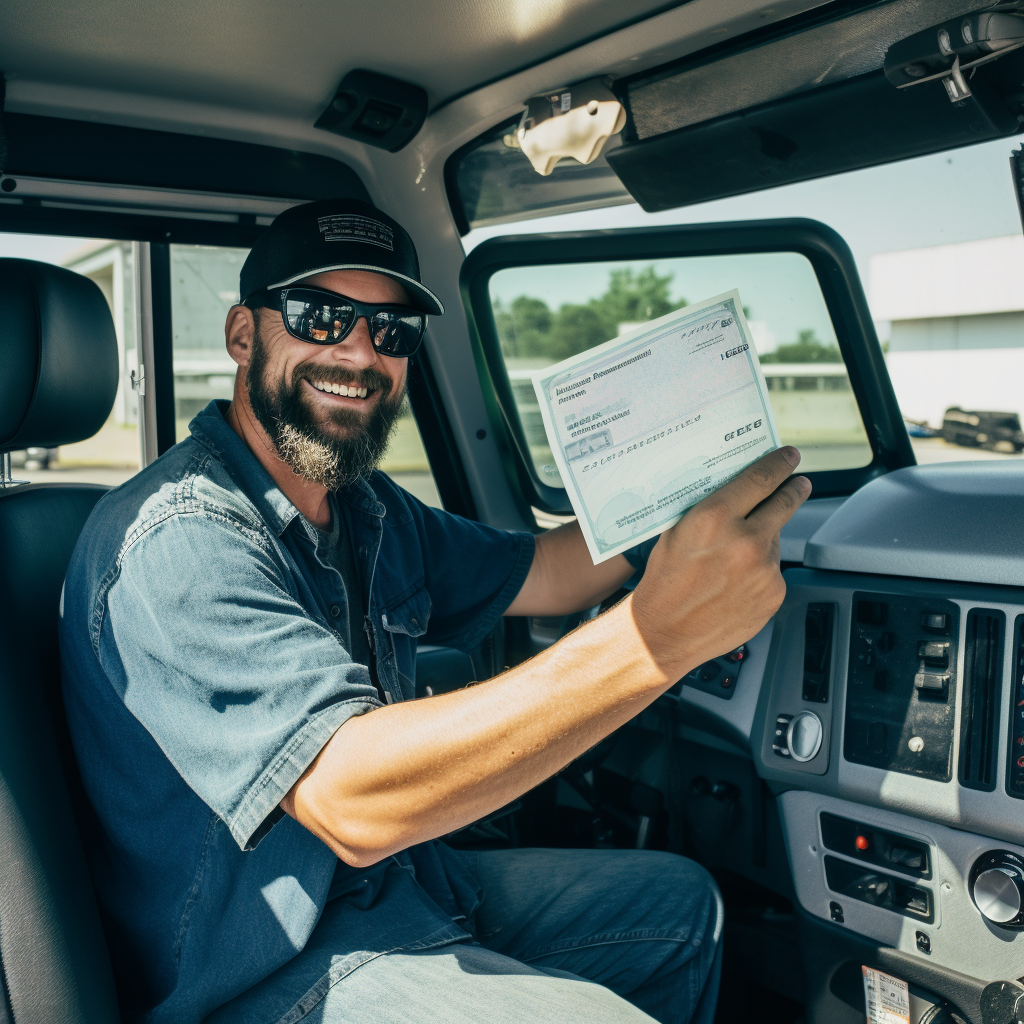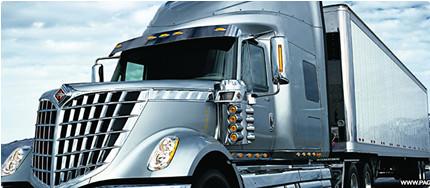Review Questions - Click On The Picture To Begin...

- Package, mark, and label the materials
- Refuse improper shipments
- Prior to transportation, checks that the shipper correctly described, marked, labeled and otherwise prepared the shipment for transportation
- Report accidents and incidents involving hazardous materials to the proper government agency
Quote From The CDL Manual:
The carrier:
- Takes the shipment from the shipper to its destination.
- Prior to transportation, checks that the shipper correctly described, marked, labeled and otherwise prepared the shipment for transportation.
- Refuses improper shipments.
- Reports accidents and incidents involving hazardous materials to the proper government agency
TruckingTruth's Advice:
Be sure to understand the different responsibilities for:
- The shipper
- The carrier
- The driver
- Making sure the shipper has identified, marked and labeled the hazardous materials properly
- Properly placarding the vehicle
- Refusing leaking packages and shipments
- The driver is responsible for all of these
Quote From The CDL Manual:
The driver:
- Makes sure the shipper has identified, marked and labeled the hazardous materials properly.
- Refuses leaking packages and shipments.
- Placards his vehicle when loading, if required.
- Safely transports the shipment without delay.
- Follows all special rules about transporting hazardous materials.
- Keeps hazardous materials shipping papers and emergency response information in the proper place
TruckingTruth's Advice:
Be sure to understand the different responsibilities for:
- The shipper
- The carrier
- The driver
- Reporting en-route accidents and incidents involving hazardous materials to the proper government agency
- Supplying placards
- preparing shipping papers
- Marking and labeling the materials
Quote From The CDL Manual:
The shipper:
- Sends products from one place to another by truck, rail, vessel or airplane.
- Uses the hazardous materials regulations to decide the product's:
- Proper shipping name
- Hazard class
- Identification number
- Correct packaging
- Correct label and markings
- Correct placards
- Must package, mark and label the materials, prepare shipping papers, provide emergency response information and supply placards.
- Must certify on the shipping paper that the shipment has been prepared according to the rules (unless you are pulling cargo tanks supplied by you or your employer)
TruckingTruth's Advice:
Be sure to understand the different responsibilities for:
- The shipper
- The carrier
- The driver
- Receive a tanker endorsement first
- Initially and at each renewal pass a security background check and a written exam about transporting hazardous materials
- Initially and at each renewal date undergo a detailed HAZMAT specific DOT Physical exam
- Pass an advanced driving test to prove your safe driving abilities
Quote From The CDL Manual:
To obtain a Hazardous Materials Endorsement on a CDL, you must initially and at each renewal pass a security background check and a written exam about transporting hazardous materials.
- Put hazard warning labels on packages
- Provide proper shipping papers, emergency response information and placards to the carrier or driver
- Shippers must do all of these things in regards to hazardous materials
- Must warn drivers and others about materials hazards
Quote From The CDL Manual:
To communicate the risk, shippers must warn drivers and others about materials hazards. The regulations require shippers to put hazard warning labels on packages, provide proper shipping papers, emergency response information and placards. These steps communicate the hazard to the shipper, the carrier and the driver.
TruckingTruth's Advice:
Be sure to understand the different responsibilities for:
- The shipper
- The carrier
- The driver
- Be sure your vehicle placards are properly displayed
- Check for the hazardous materials endorsement on your driver's license
- Law enforcement may do all of these things
- Check your shipping papers
Quote From The CDL Manual:
Inspect your vehicle before and during each trip. Law enforcement officers may stop and inspect your vehicle. When stopped, they may check your shipping papers, vehicle placards, the hazardous materials endorsement on your driver's license, and your knowledge of hazardous materials.
- Determines whether the hazardous material can be transported with a tanker truck or not
- Indicates how a product must be packaged
- Shows which type of CDL HAZMAT endorsement is needed
- Reflects the risks associated with a hazardous material
Quote From The CDL Manual:
A material's hazard class reflects the risks associated with it. The hazard class of a hazardous material is indicated by its class (or division) number, its class name, or by the letters "ORM-D." Figure 9-1 below lists class numbers, division numbers, class or division names and those sections of this subchapter that contain definitions for classifying hazardous materials, including forbidden materials.
TruckingTruth's Advice:
Be mindful of the hazard classes you are carrying as that will determine which placards are required during transportation
- Properly placard your vehicle in accordance with the rules
- Know how to clean a HAZMAT spill
- Identify hazardous materials
- Safely load shipments
Quote From The CDL Manual:
To obtain a Hazardous Materials Endorsement on a CDL, you must initially and at each renewal pass a security background check and a written exam about transporting hazardous materials. To pass the exam, you must know how to:
- Identify hazardous materials.
- Safely load shipments.
- Properly placard your vehicle in accordance with the rules.
- Safely transport shipments.
Learn the rules and follow them. Following the rules reduces the risk of injury from hazardous materials. Taking shortcuts by breaking rules is unsafe and against the law.
- Package, mark and label the materials
- All of these are shipper responsibilities
- Report en-route accidents to proper government agencies
- Placard the vehicle
Quote From The CDL Manual:
The shipper:
- Sends products from one place to another by truck, rail, vessel or airplane.
- Uses the hazardous materials regulations to decide the product's:
- Proper shipping name
- Hazard class
- Identification number
- Correct packaging
- Correct label and markings
- Correct placards
- Must package, mark and label the materials, prepare shipping papers, provide emergency response information and supply placards.
- Must certify on the shipping paper that the shipment has been prepared according to the rules (unless you are pulling cargo tanks supplied by you or your employer)
TruckingTruth's Advice:
Be sure to understand the different responsibilities for:
- The shipper
- The carrier
- The driver
- Hazard class
- Proper shipping name
- All of these must be displayed on the shipping papers
- Identification number
Quote From The CDL Manual:
The shipper:
- Sends products from one place to another by truck, rail, vessel or airplane.
- Uses the hazardous materials regulations to decide the product's:
- Proper shipping name
- Hazard class
- Identification number
- Correct packaging
- Correct label and markings
- Correct placards
- Must package, mark and label the materials, prepare shipping papers, provide emergency response information and supply placards.
- Certify on the shipping paper that the shipment has been prepared according to the rules (unless you are pulling cargo tanks supplied by you or your employer).
TruckingTruth's Advice:
While it is the shippers responsibility to provide you with the correct paperwork (with the correct and required info) as well as the placards for your vehicle, it is up to you to make sure everything is correct.
- Shipping route
- Hazard class and identification number
- All of these answers are correct
- Health tag
Quote From The CDL Manual:
The shipper:
- Sends products from one place to another by truck, rail, vessel or airplane.
- Uses the hazardous materials regulations to decide the product's:
- Proper shipping name
- Hazard class
- Identification number
- Correct packaging
- Correct label and markings
- Correct placards
- Must package, mark and label the materials, prepare shipping papers, provide emergency response information and supply placards.
- Must certify on the shipping paper that the shipment has been prepared according to the rules (unless you are pulling cargo tanks supplied by you or your employer)
TruckingTruth's Advice:
Be sure to understand the different responsibilities for:
- The shipper
- The carrier
- The driver
- Reports accidents and incidents involving hazardous materials to the proper government agency
- Must package, mark and label the materials, prepare shipping papers, provide emergency response information and supply placards
- Install proper placards on the vehicle
- The carrier is not responsible for any of these
Quote From The CDL Manual:
The carrier:
- Takes the shipment from the shipper to its destination.
- Prior to transportation, checks that the shipper correctly described, marked, labeled and otherwise prepared the shipment for transportation.
- Refuses improper shipments.
- Reports accidents and incidents involving hazardous materials to the proper government agency
TruckingTruth's Advice:
Be sure to understand the different responsibilities for:
- The shipper
- The carrier
- The driver
- Placard the vehicle
- Prepare shipping papers
- Keep hazardous materials shipping papers and emergency response information in the proper place
- Refuse leaking packages and shipments
Quote From The CDL Manual:
The driver:
- Makes sure the shipper has identified, marked and labeled the hazardous materials properly.
- Refuses leaking packages and shipments.
- Placards his vehicle when loading, if required.
- Safely transports the shipment without delay.
- Follows all special rules about transporting hazardous materials.
- Keeps hazardous materials shipping papers and emergency response information in the proper place
TruckingTruth's Advice:
Be sure to understand the different responsibilities for:
- The shipper
- The carrier
- The driver
- They tell shippers how to package the materials safely and drivers how to load, transport and unload the materials
- Require all different classes of hazardous materials to be shipped in separate trailers to avoid mixing of chemicals
- Requirements that state trucks carrying hazardous materials are not allowed in residential neighborhoods
- Rules for isolating a spilled hazardous material
Quote From The CDL Manual:
Transporting hazardous materials can be risky. The regulations are intended to protect you, those around you, and the environment. They tell shippers how to package the materials safely and drivers how to load, transport and unload the materials. These are called "containment rules."








 TT On Facebook
TT On Facebook